Elizabeth police department
The following is an overview of the set up and operations of EPD and the results of their Drone as a First Responder (DFR) program
Program Start
06/2022
Population
128,000
Typography
Metropolitan
Table of Contents
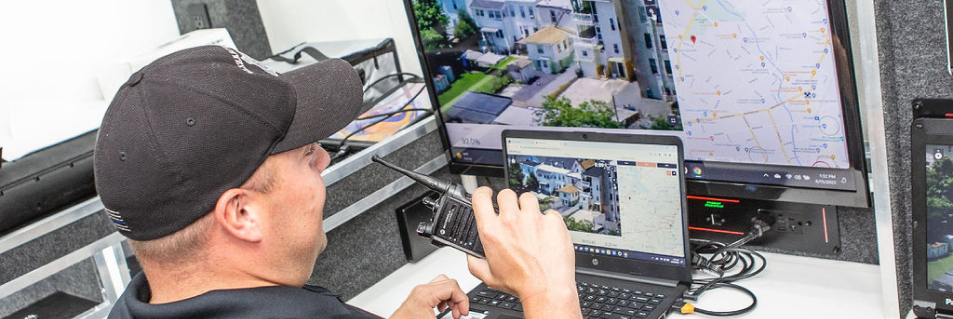
The Results
The following are the results of Elizabeth Police Department’s DFR program from 05/31/2022 – 01/13/2023 running deployments four days a week on a ten hour shift.
Missions
1,390
A mission is defined as any time in which the UAS was launched, used on a call for service, and then landed. EPD regularly flies 2-3 calls on a flight which is why the number of calls cleared or assisted is close to flights. Not every launch is categorized as an assist or call cleared. If the UAS does not directly clear the call or video feed from the call did not result in information provided to officers on the ground, the call was not categorized as a cleared or assisted call.
Calls Assisted
431
A call is considered assisted if information from the live video feed was used by first responders to either clear a call that first responders also responded too (i.e. a missing person) or the information assisted with the call types intended outcome. Real examples from the program include guiding officers to the location of the suspect and identifying stolen vehicles.
Calls Cleared
25%
A call is considered cleared by the DFR Unit if there is sufficient evidence provided by the video feed that the call is no longer active. If there is a suspicious persons call, the UAS can quickly and efficiently scan a large area for up to 55 minutes. If the call is cleared from the CAD system by UAS footage only, this is considered a cleared call. It should be specified that high priority calls will not be cleared solely by a UAS.
Arrests
16
Arrests are attributed to the DFR Unit for two reasons. One way is that the UAS arrived on scene before first responders and the intel gathered led to the arrest. The second way is that the UAS recorded video footage of the crime and this led to an arrest being possible. A real life example of an arrest made by the DFR unit involved live video feed of the felony, a clear image of the license plate, and following the vehicle and guiding officers to its location for the arrest.
Why DFR?
Elizabeth Police Department has had one of the most robust drone programs in the country for the better half of a decade. The benefits that the UAS unit has brought to their fellow first responders is tremendous. The question for Detective Luis Figueiredo, the UAS Coordinator at EPD, became how can we provide the situational awareness that our UAS unit offers on more than just priority one calls a few times a month?
With the traditional manual deployment model in which drone coverage is reliant on the response time of a trained pilot, this goal was largely unobtainable.
Drone as a First Responder is designed to separate the benefits a UAS program provides with the response time of a trained pilot. The Elizabeth PD UAS Unit can now have a drone overhead to any call within minutes of the request for service. This enhances the UAS program in two ways: first responders are now able to gain the critical intel that UAS can yield before arriving on scene and the information can be given hundreds of times a week as oppose to a few times a month.
Additionally, the EPD UAS Unit clears lower priority calls in the queue that traditionally would sit there for hours due to the unavailability of a unit to respond. See Results for information on exactly how many calls they are able to assist.
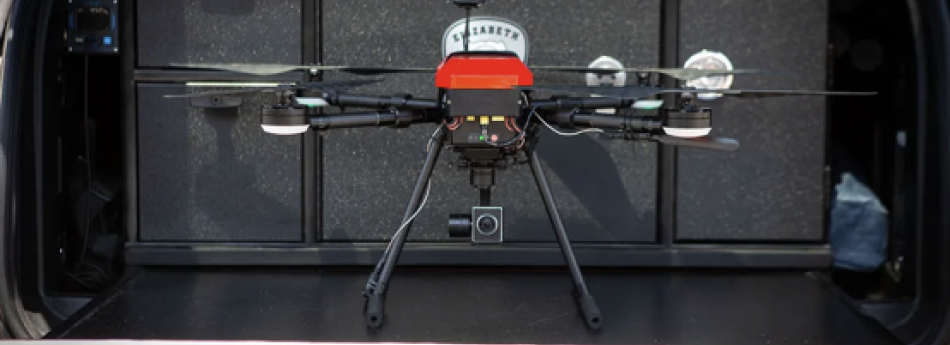
The FAA Process
Elizabeth, NJ is in Class B Airspace. The beyond visual line of sight (BVLOS) waiver allows for UAS to operate at 200 ft in most of the city with portions at 100 ft. Elizabeth was a difficult airspace to gain a BVLOS waiver given that Newark International (EWR) is extremely close. As you can see in the image below, all of Elizabeth, NJ is in class B airspace and most of it is in 0 ft and 50 ft.
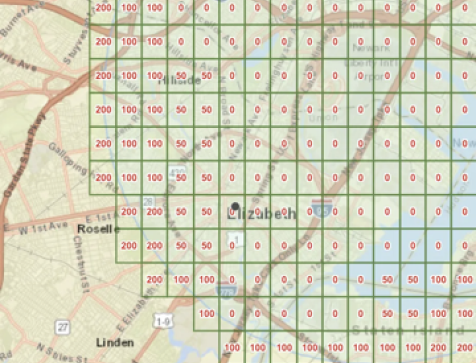
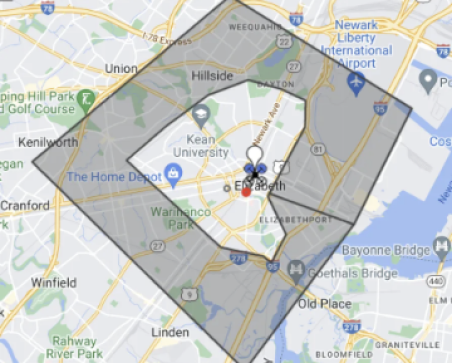
We began by obtaining a jurisdictional certificate of authorization (JCOA) needed for a public safety agency who would like to operate a Drone as a First Responder (DFR) program in airspace other than class G. The JCOA was specific to the Knighthawk which was an important specification for getting the BVLOS waiver. Once we received the official JCOA on behalf of EPD, we submitted our Concept of Operations (CONOPS) which outlines the specifics of exactly how the proposed DFR operation would work. We selected the launch locations and specified the area of operations and the proposed max altitudes.
Once we submitted the CONOPS, the FAA reached out to schedule a waiver team meeting in which Detective Luis Figueiredo made a presentation summarizing the CONOPS. The focus was to explain the mitigation EPD would use in place of line of sight flying. Because of Knighthawk’s LTE connection, Paladin is able to get BVLOS waivers that do not require a VO on the rooftop such as in a radio-based DFR model. The LTE connection allows the Knighthawk to fly miles away from its home base, a distance from which no singular VO at the launch location could maintain reliable eye contact of the UAS airspace. Instead we use a network of VO’s to accomplish the same goal which drastically reduces both manpower needs and operational costs of the program. The waiver team meeting then consisted of a Q&A session in which the main focus was making sure we had thought of all the potential risks such as an unaccounted for heliport at a hospital. Elizabeth PD was granted their official waiver in May of 2022.
Onboarding
The onboarding was longer than usual as Paladin felt that additional testing and training was important considering the launch location’s proximity to Newark International. Our onboarding team spent 10 days with EPD vigorously testing the geofence (by flying the drone into it multiple times) to ensure the UAS would not fly into restricted airspace. We then trained two pilots in addition to Detective Figueiredo on how to follow the FAA guidelines outlined in the CONOPS we submitted for the BVLOS waiver.
The DFR team at EPD also had some decisions to make regarding the deployment model they wished to do. The BVLOS waiver was specific to their LTE-enabled drone which uses a network of visual observers instead of the traditional VO needing to be on a rooftop. They also wanted to try a dual model in which they deployed an M300 using Paladin’s Watchtower software. For this, the PIC remained on a parking structure keeping line of sight with the drone while doing the DFR model of deploying the drone to 911 calls as they came in. Ultimately, the need for a PIC or VO to be on the roof was burdensome. Elizabeth is also a metropolitan area with tall buildings and so the radio-based UAS was only able to make it around 0.5 miles away. They decided to continue on with a singular drone to able to cover their entire city while being able to operate it from the police department.
EPD began deploying to real 911 emergencies within a few days of onboarding. Read Results to see what they accomplished in only 6 weeks.
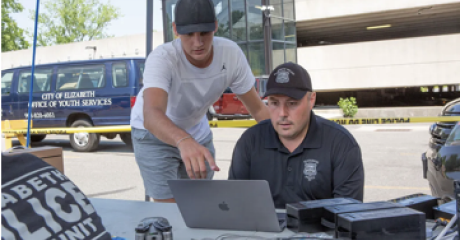
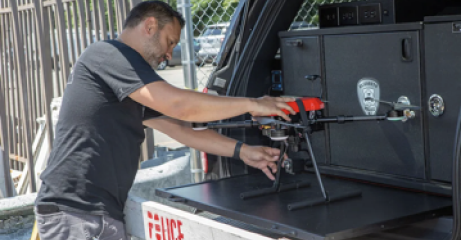
Operation Overview
Elizabeth Police Department is currently using one Knighthawk and the Watchtower streaming, data management, and DFR autonomous controls. The DFR program has two main objectives.
When a high priority call is not in progress, the UAS is clearing calls that have remained in the CAD queue for extended times. For example, a suspicious person’s call was not answered for 30 minutes due to officers being preoccupied. The drone was deployed to identify if the person was still in the area based on information given by the caller. If the person is no longer there, the call is cleared. This allows officers the ability to respond to higher priority calls without letting the CAD queue overflow with calls for service. In theme with this use, the DFR program assists officers. If there is a missing person, the UAS is able to cover more ground in search of this person in a shorter amount of time. This allows for units on the ground to search other areas like inside a store, home, and other places a UAS can’t access.
The second main objective is to provide critical situational awareness on high priority calls. For example, EPD responded to a multi agency vehicle police chase that not only went through our city but also crossed over into Staten Island. Our DFR program was able to monitor the chase and provide updates to responding units which resulted in the arrest of one suspect and the recovery of a stolen vehicle wanted for recent robberies.
See Results for more data on the program’s accomplishments.
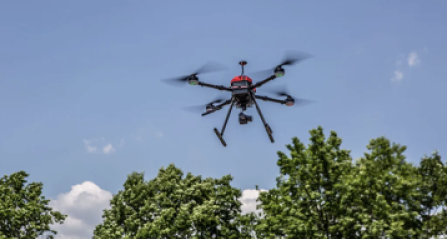
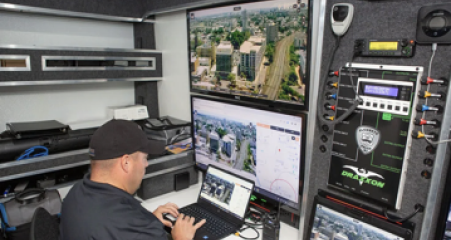
UAS Coordinator
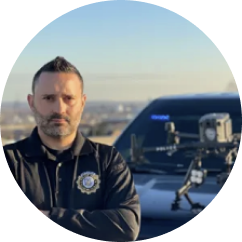
Detective Luis Figueiredo
Drone Detective™ / Public Safety UAS Program Developer
Luis Is a 16 year old veteran police officer that has been operating UAS’s for over 10 years.

Detective Luis Figueiredo
Drone Detective™ / Public Safety UAS Program Developer
Luis Is a 16 year old veteran police officer that has been operating UAS’s for over 10 years.
Luis is a Narcotics Detective, Chief UAS Pilot and UAS Program Coordinator with the Elizabeth Police Department in Elizabeth, NJ. He is also a Task Force Officer assigned to Homeland Security Investigations, under the Department of Homeland Security. Luis started the Elizabeth Police Department’s UAS unit in 2017 and was amongst the first in the Country to receive a Certificate Of Authorization from the FAA to operate in Class Bravo airspace.
Luis has also assisted numerous departments throughout the State of New Jersey develop their UAS program’s, providing assistance with SOP’s, equipment purchases, FAA certifications and training. Since beginning his department’s UAS program he has successfully expanded the program from one operator to over fifteen full time pilots. These pilots provide situational awareness and tactical over watch for operations ranging from search and rescue, fleeing suspects, accident reconstruction, medical calls, scene documentation, aerial photography, and other incidents. Luis also provides UAS assistance to local, state, and federal agencies throughout the Tri-State area.
His extensive public safety deployments have resulted in over 600 hours of operating the following platforms: DJI Matrice 300 / 210, Mavic Enterprise, and Autel EVO II. Luis’s goal is to continue introducing UAS technology including DFR to other public safety agencies while increasing the public’s knowledge on the role UAS’s provide in the day to day operations.
